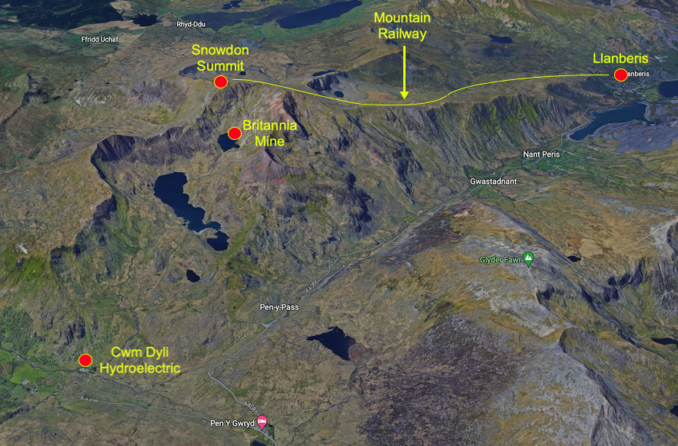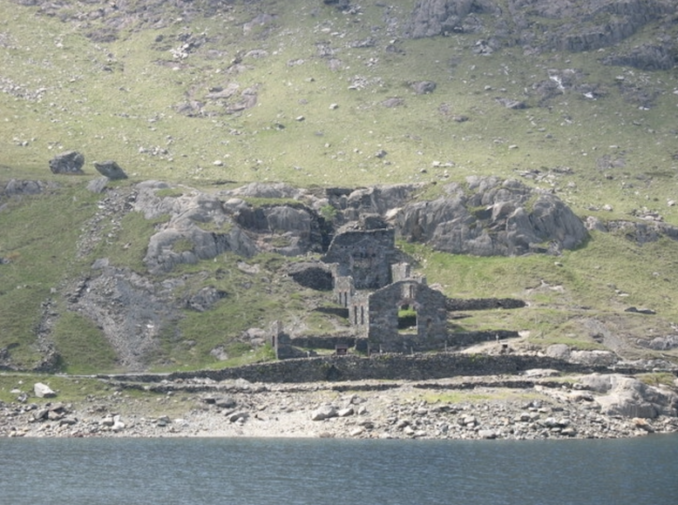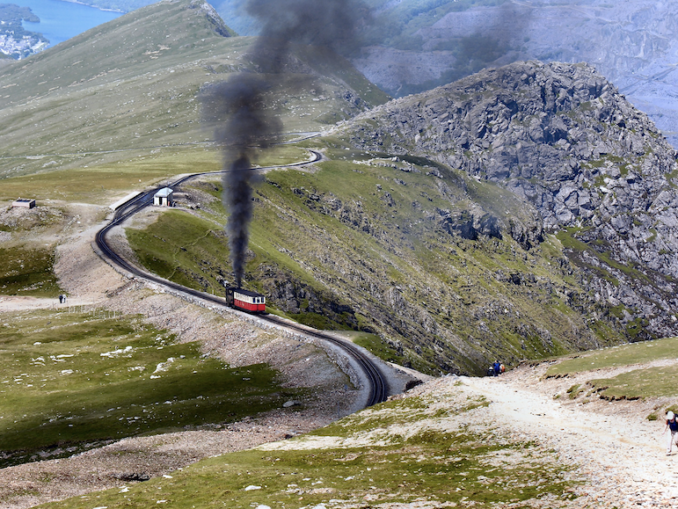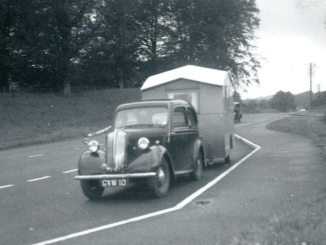Mount Snowdon (Yr Wyddfa in Welsh) is the highest mountain in Wales, standing at an elevation of 3,560ft above sea level. As such, it holds the title as the highest point in the British Isles outside of Scotland. Located in the Snowdonia National Park in Gwynedd, it is a popular destination and the busiest mountain in the UK. The mountain is distinguished for its rare flora and fauna, hence its designation as a national nature reserve.
Snowdon offers various paths to the summit for climbers and walkers. These range from between seven and nine miles and can take anywhere between four to seven hours to complete depending on fitness level, experience, and weather. For those less inclined to hike, the Snowdon Mountain Railway offers an alternative way to reach the summit with trains running to the peak until the end of October weather permitting. Whether you’re interested in history, flora and fauna, or just stunning views, Mount Snowdon is a must-see destination.
My grandparents visited during their 1932 motorcycle and sidecar road trip to North Wales, but after the Cwm Dyli hydroelectric power station on the A498 (roughly eleven miles from the summit by road and mountain railway) there are no more photos. We shall assume they conquered the mountain despite both the lack of evidence and my grandmother being very pregnant. Although a sneaking suspicion lingers that rather than reach the summit on foot or by railway they may have addressed rough tracks (motorbike trials style) until stopped by the terrain.
Geology
As they did they will have passed through a landscape formed through the geological process of subduction. Subduction zones are areas where one underground tectonic plate is forced under another, leading to the creation of mountains, volcanoes, and other geological features. This process involves the movement and collision of the Earth’s crust, resulting in the uplift and formation of mountains such as Snowdon.

Snowdon massif,
Unknown photographer – Licence CC BY-SA 3.0
Subsequently, glaciers significantly shaped the landscape during the last Ice Age creating huge U-shaped valleys and corries (or ‘cwms’) that are clearly visible in Snowdonia today. Other glacial landforms that can be seen nearby include roches moutonnées (bedrock bumps), glacial erratics (out of place large rocks) and moraines (material left behind by a moving glacier). The glacier here was part of a larger glacial system that created Dyffryn Ogwen, forming valleys from smaller glaciers known as ‘hanging valleys’. This glacial activity played a crucial role in sculpting the current alpine topography of Mount Snowdon, making it a fascinating study of geological history.
As for human habitation, despite numerous archaeological surveys, no prehistoric remains have been identified near the summit, making its archaeological history quite elusive. There have been suggestions of a prehistoric cairn on the summit, possibly the grave of the giant Rhita Gawr, but this is based more on assumption than concrete evidence.
Snowdonians
When early peoples did venture here they cloaked the mountain in folklore. A rich Welsh mythology dates back to the early Celtic times. That Rhita Gawr was a mythical giant who was defeated by King Arthur. Another Arthurian story tells of a fearsome afanc (water monster) relocated from a lake at the foot of Mount Snowdon to Llyn yr Afanc in Betws-y-Coed.
The Welsh name for Mount Snowdon, Yr Wyddfa, translates to “the tumulus” or “the barrow”, possibly referring to Rhita Gawr’s burial mound. Moreover, it is believed that the magical and powerful sword of King Arthur, Excalibur, was thrown into Glaslyn, a lake south of the summit close to the reservoir for Cwm Dyli power station, by Sir Bedivere following Arthur’s death.

© Google Maps 2023, Google licence
More recently, human populations were attracted by nature’s gifts brought to the surface and exposed by those ancient forces of subduction and glaciation. Evidence of early mining activities is scattered across the area. The region’s dolomitised limestone deposits are rich in copper with residuals from the Britannia Copper Mine being visible along the Miners’ Track, a popular walk to the summit originally used by the local industry. This track ascends the mountain from the south, offering trekkers a glimpse into the industrial history of the area.
Besides the copper mine, there was a Britannia Copper Mill built in 1898 to process ores from above Llyn Glaslyn that were transported to the mill by an aerial ropeway. The mine and mill closed in 1916. Other minerals present include lead, zinc, iron, gold and manganese — all mined at one time or another. And perhaps most importantly, slate, the North Wales industry that once ‘roofed the world’.
The remains of this industry can be seen in Bethesda, Blaenau Ffestiniog and Llanberis — all just a stone’s throw from the boundaries of the Snowdonia National Park. The remains of slate quarries can also be seen within the boundaries of the park. Gorseddau Quarry was a small quarry in Cwmystradllyn with about 200 workers in 1859. The quarry closed in 1867 due to insufficient slate production. The remains of the quarry’s slate mill, Ynys-y-pandy, still stand today.
There are also traces of mining in the Bryniau, Poethion, and Pyllau valleys which surround Snowdon. Although not directly on Mount Snowdon, the Great Orme mine in North Wales showcases Bronze Age metal extraction, highlighting the long history of mining in the region.
Nowadays the old miners’ tracks attract tourists. The Miners’ Track proper begins at the Pen y Pass car park and passes by the ruins of old miners’ barracks. This track offers a glimpse into the past, with views of the Nant Gwynant valley and landmarks like the Snowdon Horseshoe. It also involves a challenging climb towards the intersection of the Miners’ and Pyg Tracks, providing an adventurous experience for hikers.

The Britannia Copper Mill on the shores of Llyn Llydaw,
Eric Jones – Licence CC BY-SA 2.0
Visitors
Rather than tourists, the first curious visitors from outside the area were seekers after knowledge. Early recorded ascents were by scientists, especially botanists and herbalists. A number of Welsh-speaking botanists and herbalists lived in North Wales and their local knowledge attracted others with whom they were in correspondence.
The first documented ascent of Snowdon was made by one such, Mr Thomas Johnson, in 1639. These early scientists rarely described the views or recorded their emotional response to being on the highest place in the southern British Isles, rather they came to see the plants. Besides the rarity value, it was thought the harsh conditions in which the local flora lived might provide herbal ingredients beneficial to the human constitution.
Other early visitors were checking and calculating the heights of mountains. In 1682 John Caswell, Savilian Professor of Astronomy, measured the height of Snowdon using trigonometry. Calculating it to 3,720 ft, he was wrong. Eagle-eyed Puffins will have spotted at the top of this article the actual elevation is 3,560 ft.
Several other famous scientists visited Snowdon to test and refine equipment. These included Edmond Halley (discoverer of the comet) who visited in 1697 to carry out experiments for the Royal Society using a barometer to establish the relationship between atmospheric pressure and height above sea level. Unimpressed, he described the locale as ‘this horrid spot of hills’.
Serious mountaineers’ attempts to ascend Snowdon and surrounding peaks began in the 1860s. It later became a popular base for mountaineering, marking an important chapter in the history of rock climbing in the United Kingdom. Less adventurous types might prefer the Snowdon Mountain Railway. Its journey starts from Llanberis and covers a distance of 4 miles and 55 chains to reach the summit. This 2ft 7 1/2 inch single track railway is unique as it’s the only public rack and pinion railway in the UK, rising as it does 3,140ft at an average gradient of 1 in 7.83
The Railway
Operating daily from April to October, weather permitting, the railway offers an incredible journey to Snowdon Summit. The journey takes approximately 60 minutes, including a 30-minute stopover at Hafod Eryri, the UK’s highest visitor centre. During the early season, trains also stop at Clogwyn station, located ¾ of the way up the mountain.

Clogwyn railway station,
Denis Egan – Licence CC BY-SA 2.0
The railway has a significant history. First proposed in 1869, construction began in 1894 and culminated with an opening in April 1896. The cost was £64,000 which according to the Bank of England’s online inflation calculator would be a hefty but not ridiculous £7,000,000 in today’s money. Despite a rocky start, with a derailment on its opening day, the railway now successfully carries over 140,000 passengers annually.
On that opening day, an alarming incident killed one and left several injured. While descending, an engine left the track and fell over a precipice on the Llanberis Pass side of the mountain. The carriages came to a standstill but several passengers were injured. The following day, a Mr Ellis Roberts proprietor of the Padarn Villa Hotel in Llanberis, died of his injuries. The fireman and driver had miraculous escapes, jumping from the engine just before it plunged over the precipice.
A Major Marindin had previously inspected and passed the railway on behalf of the Board of Trade and inspected once more soon after the accident. He concluded the engine had jumped the rack rail and failed to engage the rack gear again, therefore becoming unmanageable. Apart from ‘a bit of a shine’ on the rack at the point of the accident, Major Marindin was at a loss to explain further and, given the railway was not under an Act of Parliament, thought the Board of Trade had no authority to order an enquiry. Eventually, a fuller investigation was held and the accident was blamed on a fallen boulder.
In better times, close to the year of my grandparents’ visit and in the days when regional newspapers reported such things, The Western Mail wrote that the Snowdon Mountain Railway had made a profit of £5,634 in 1936. Debenture interest of £1,780 was deducted and £6,096 was ‘brought in’ making £9,950 from which a dividend of 5% was deducted, leaving £6,450 to forward. In addition, £500 was set in reserve for the renewal of locomotives. According to the Bank of England’s inflation calculator, £5,634 in 1936 would be a very healthy £326,000 today. Additionally, those £500 locomotives were costing £29,000 at present-day prices.
Simpler times for railway industry accountants!
© Always Worth Saying 2023



